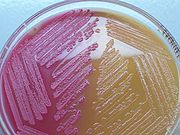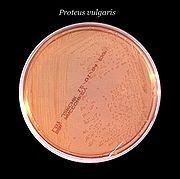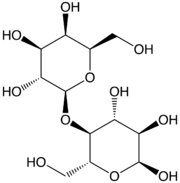
MacConkey agar
Encyclopedia



Alfred Theodore MacConkey
Alfred Theodore MacConkey was the British bacteriologist who developed MacConkey's agar, a selective medium that is used in the diagnosis of enteric pathogens....
agar is a culture
Microbiological culture
A microbiological culture, or microbial culture, is a method of multiplying microbial organisms by letting them reproduce in predetermined culture media under controlled laboratory conditions. Microbial cultures are used to determine the type of organism, its abundance in the sample being tested,...
medium designed to grow Gram-negative
Gram-negative
Gram-negative bacteria are bacteria that do not retain crystal violet dye in the Gram staining protocol. In a Gram stain test, a counterstain is added after the crystal violet, coloring all Gram-negative bacteria with a red or pink color...
bacteria
Bacteria
Bacteria are a large domain of prokaryotic microorganisms. Typically a few micrometres in length, bacteria have a wide range of shapes, ranging from spheres to rods and spirals...
and stain them for lactose
Lactose
Lactose is a disaccharide sugar that is found most notably in milk and is formed from galactose and glucose. Lactose makes up around 2~8% of milk , although the amount varies among species and individuals. It is extracted from sweet or sour whey. The name comes from or , the Latin word for milk,...
fermentation
Industrial fermentation
Industrial fermentation is the intentional use of fermentation by microorganisms such as bacteria and fungi to make products useful to humans. Fermented products have applications as food as well as in general industry.- Food fermentation :...
.
Contents
It contains bile salts (to inhibit most Gram-positiveGram-positive
Gram-positive bacteria are those that are stained dark blue or violet by Gram staining. This is in contrast to Gram-negative bacteria, which cannot retain the crystal violet stain, instead taking up the counterstain and appearing red or pink...
bacteria, except Enterococcus
Enterococcus
Enterococcus is a genus of lactic acid bacteria of the phylum Firmicutes. Enterococci are Gram-positive cocci that often occur in pairs or short chains, and are difficult to distinguish from streptococci on physical characteristics alone. Two species are common commensal organisms in the...
and some species of Staphylococcus
Staphylococcus
Staphylococcus is a genus of Gram-positive bacteria. Under the microscope they appear round , and form in grape-like clusters....
i.e. Staphylococcus aureus), crystal violet
Crystal violet
Crystal violet or Gentian violet is a triarylmethane dye. The dye is used as a histological stain and in Gram’s method of classifying bacteria. Crystal violet has antibacterial, antifungal, and anthelmintic properties and was formerly important as a topical antiseptic...
dye (which also inhibits certain Gram-positive bacteria), neutral red
Neutral red
Neutral Red is a eurhodin dye used for staining in histology. It stains lysosomes red. It is used as a general stain in histology, as a counterstain in combination with other dyes, and for many staining methods. Together with Janus Green B, it is used to stain embryonal tissues and supravital...
dye (which stains microbes fermenting lactose), lactose
Lactose
Lactose is a disaccharide sugar that is found most notably in milk and is formed from galactose and glucose. Lactose makes up around 2~8% of milk , although the amount varies among species and individuals. It is extracted from sweet or sour whey. The name comes from or , the Latin word for milk,...
and peptone.
Composition:
- Peptone - 17 g
- Proteose peptone - 3 g
- LactoseLactoseLactose is a disaccharide sugar that is found most notably in milk and is formed from galactose and glucose. Lactose makes up around 2~8% of milk , although the amount varies among species and individuals. It is extracted from sweet or sour whey. The name comes from or , the Latin word for milk,...
- 10 g - Bile salts - 1.5 g
- Sodium chlorideSodium chlorideSodium chloride, also known as salt, common salt, table salt or halite, is an inorganic compound with the formula NaCl. Sodium chloride is the salt most responsible for the salinity of the ocean and of the extracellular fluid of many multicellular organisms...
- 5 g - Neutral redNeutral redNeutral Red is a eurhodin dye used for staining in histology. It stains lysosomes red. It is used as a general stain in histology, as a counterstain in combination with other dyes, and for many staining methods. Together with Janus Green B, it is used to stain embryonal tissues and supravital...
- 0.03 g - AgarAgarAgar or agar-agar is a gelatinous substance derived from a polysaccharide that accumulates in the cell walls of agarophyte red algae. Throughout history into modern times, agar has been chiefly used as an ingredient in desserts throughout Asia and also as a solid substrate to contain culture medium...
- 13.5 g - WaterWaterWater is a chemical substance with the chemical formula H2O. A water molecule contains one oxygen and two hydrogen atoms connected by covalent bonds. Water is a liquid at ambient conditions, but it often co-exists on Earth with its solid state, ice, and gaseous state . Water also exists in a...
- add to make 1 litre; adjust pH to 7.1 +/- 0.2
There are many variations of MacConkey agar depending on the need. If the spreading or swarming of Proteus species is NOT required, sodium chloride is omitted. Crystal violet
Crystal violet
Crystal violet or Gentian violet is a triarylmethane dye. The dye is used as a histological stain and in Gram’s method of classifying bacteria. Crystal violet has antibacterial, antifungal, and anthelmintic properties and was formerly important as a topical antiseptic...
at a concentration of 0.0001% (0.001 g per litre) is included when we need to check if Gram-positive bacteria are inhibited.
History
The medium was developed by Alfred Theodore MacConkeyAlfred Theodore MacConkey
Alfred Theodore MacConkey was the British bacteriologist who developed MacConkey's agar, a selective medium that is used in the diagnosis of enteric pathogens....
while working as a bacteriologist
Bacteriology
Bacteriology is the study of bacteria. This subdivision of microbiology involves the identification, classification, and characterization of bacterial species...
for the Royal Commission on Sewage Disposal.
Uses
Acting as a visual pHPH
In chemistry, pH is a measure of the acidity or basicity of an aqueous solution. Pure water is said to be neutral, with a pH close to 7.0 at . Solutions with a pH less than 7 are said to be acidic and solutions with a pH greater than 7 are basic or alkaline...
indicator, the agar distinguishes those Gram-negative bacteria that can ferment the sugar lactose (Lac+) from those that cannot (Lac-).
This medium is also known as an "indicator medium" and a "low selective medium". Absence of electrolytes serves to inhibit swarming by Proteus species.
Lac+
By utilizing the lactose available in the medium, Lac+ bacteria such as Escherichia coliEscherichia coli
Escherichia coli is a Gram-negative, rod-shaped bacterium that is commonly found in the lower intestine of warm-blooded organisms . Most E. coli strains are harmless, but some serotypes can cause serious food poisoning in humans, and are occasionally responsible for product recalls...
, Enterobacter
Enterobacter
Enterobacter is a genus of common Gram-negative, facultatively-anaerobic, rod-shaped bacteria of the family Enterobacteriaceae. Several strains of the these bacteria are pathogenic and cause opportunistic infections in immunocompromised hosts and in those who are on mechanical ventilation...
and Klebsiella
Klebsiella
Klebsiella is a genus of non-motile, Gram-negative, oxidase-negative, rod-shaped bacteria with a prominent polysaccharide-based capsule. It is named after the German microbiologist Edwin Klebs...
will produce acid
Acid
An acid is a substance which reacts with a base. Commonly, acids can be identified as tasting sour, reacting with metals such as calcium, and bases like sodium carbonate. Aqueous acids have a pH of less than 7, where an acid of lower pH is typically stronger, and turn blue litmus paper red...
, which lowers the pH of the agar below 6.8 and results in the appearance of red/pink colonies. The bile salts precipitate in the immediate neighborhood of the colony, causing the medium surrounding the colony to become hazy.
Lac-
Non-Lactose fermenting bacteria such as SalmonellaSalmonella
Salmonella is a genus of rod-shaped, Gram-negative, non-spore-forming, predominantly motile enterobacteria with diameters around 0.7 to 1.5 µm, lengths from 2 to 5 µm, and flagella which grade in all directions . They are chemoorganotrophs, obtaining their energy from oxidation and reduction...
, Proteus species
Proteus (bacterium)
Proteus is a genus of Gram-negative Proteobacteria.-Clinical significance:Three species—P. vulgaris, P. mirabilis, and P. penneri—are opportunistic human pathogens. Proteus includes pathogens responsible for many human urinary tract infections. P. mirabilis causes wound and urinary...
, Pseudomonas aeruginosa
Pseudomonas aeruginosa
Pseudomonas aeruginosa is a common bacterium that can cause disease in animals, including humans. It is found in soil, water, skin flora, and most man-made environments throughout the world. It thrives not only in normal atmospheres, but also in hypoxic atmospheres, and has, thus, colonized many...
and Shigella
Shigella
Shigella is a genus of Gram-negative, nonspore forming, non-motile, rod-shaped bacteria closely related to Escherichia coli and Salmonella. The causative agent of human shigellosis, Shigella causes disease in primates, but not in other mammals. It is only naturally found in humans and apes. During...
cannot utilize lactose, and will use peptone instead, with the exception of Shigella sonnei, which is a late lactose fermentor. This forms ammonia
Ammonia
Ammonia is a compound of nitrogen and hydrogen with the formula . It is a colourless gas with a characteristic pungent odour. Ammonia contributes significantly to the nutritional needs of terrestrial organisms by serving as a precursor to food and fertilizers. Ammonia, either directly or...
, which raises the pH of the agar
Agar
Agar or agar-agar is a gelatinous substance derived from a polysaccharide that accumulates in the cell walls of agarophyte red algae. Throughout history into modern times, agar has been chiefly used as an ingredient in desserts throughout Asia and also as a solid substrate to contain culture medium...
, and leads to the formation of white/colorless colonies formed in the plate.
But they can also look golden to brown with dark centers. They are circular colonies and arranged randomly.
Slow
Some organisms ferment lactose slowly or weakly, and are sometimes put in their own category. These include SerratiaSerratia
Serratia is a genus of Gram-negative, facultatively anaerobic, rod-shaped bacteria of the Enterobacteriaceae family. The most common species in the genus, S. marcescens, is normally the only pathogen and usually causes nosocomial infections. However, rare strains of S. plymuthica, S. liquefaciens,...
and Citrobacter
Citrobacter
Citrobacter is a genus of Gram-negative coliform bacteria in the Enterobacteriaceae family.The species C. amalonaticus, C. koseri, and C. freundii use solely citrate as a carbon source...
.
Variant
A variant, Sorbitol-MacConkey agarSorbitol-MacConkey agar
Sorbitol MacConkey agar is a variant of traditional MacConkey agar used in the detection of E. coli O157:H7. Traditionally, MacConkey agar has been used to distinguish those bacteria that ferment lactose from those that do not...
, (with the addition of additional selective agents) can assist in the isolation and differentiation of enteropathogenic E. coli serotype
Serotype
Serotype or serovar refers to distinct variations within a subspecies of bacteria or viruses. These microorganisms, viruses, or cells are classified together based on their cell surface antigens...
s such as E. coli O157:H7, by the presence of white circular colonies that are non-sorbitol fermenting.

